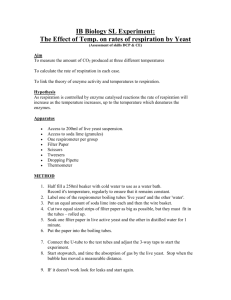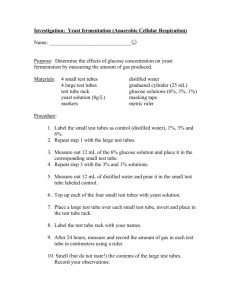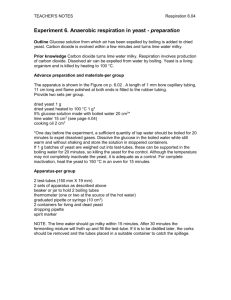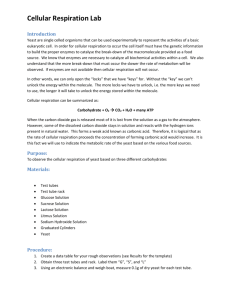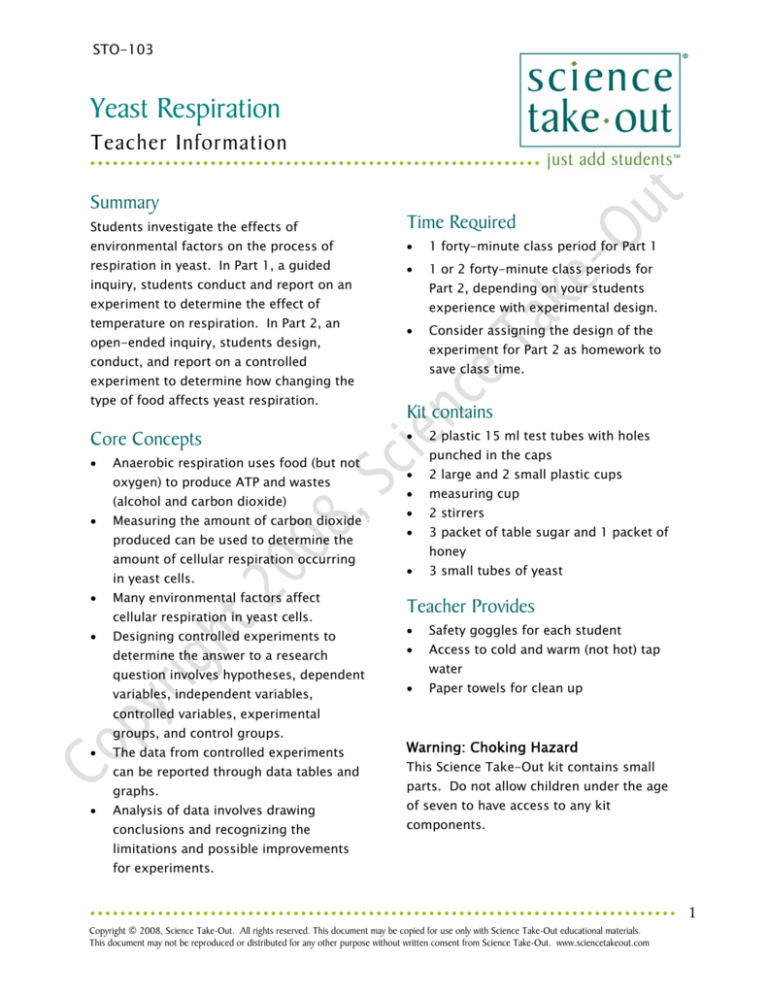
STO-103
Yeast Respiration
Teacher Information
Summary
Students investigate the effects of
environmental factors on the process of
respiration in yeast. In Part 1, a guided
inquiry, students conduct and report on an
Time Required
1 forty-minute class period for Part 1
1 or 2 forty-minute class periods for
Part 2, depending on your students
experiment to determine the effect of
temperature on respiration. In Part 2, an
open-ended inquiry, students design,
experience with experimental design.
experiment for Part 2 as homework to
conduct, and report on a controlled
save class time.
experiment to determine how changing the
type of food affects yeast respiration.
Core Concepts
Anaerobic respiration uses food (but not
oxygen) to produce ATP and wastes
(alcohol and carbon dioxide)
Measuring the amount of carbon dioxide
produced can be used to determine the
amount of cellular respiration occurring
in yeast cells.
Many environmental factors affect
cellular respiration in yeast cells.
Designing controlled experiments to
Kit contains
2 plastic 15 ml test tubes with holes
punched in the caps
2 large and 2 small plastic cups
measuring cup
2 stirrers
3 packet of table sugar and 1 packet of
honey
3 small tubes of yeast
Teacher Provides
determine the answer to a research
variables, independent variables,
question involves hypotheses, dependent
Consider assigning the design of the
Safety goggles for each student
Access to cold and warm (not hot) tap
water
Paper towels for clean up
controlled variables, experimental
groups, and control groups.
The data from controlled experiments
Warning: Choking Hazard
can be reported through data tables and
This Science Take-Out kit contains small
Analysis of data involves drawing
of seven to have access to any kit
graphs.
parts. Do not allow children under the age
conclusions and recognizing the
components.
limitations and possible improvements
for experiments.
1
Copyright © 2008, Science Take-Out.
Take-Out, LLC.
All rights
reserved.
All rights
reserved.
This document may be copied for use only with Science Take-Out educational materials.
www.sciencetakeout.com
This
document may not be reproduced or distributed for any other purpose without written consent from Science Take-Out. www.sciencetakeout.com
Reusing Yeast Respiration kits
Teachers will need to instruct students on how to handle clean-up and return of the re-usable
kit materials. For example, teachers might provide the following information for students:
Rinse with water and dry
Discard
Empty packets of sugar
Return to kit
with paper towel
and honey
Large cups, small cups,
measuring cup
Stirrers
Labeled tubes for yeast
Large cups, small cups,
measuring cup (rinsed)
Test tubes
Test tubes (rinsed)
Stirrers (rinsed)
Refills for Yeast Respiration kits are available at www.sciencetakeout.com. The 10 Kit Refill
Pack includes the following materials:
1 Quick Guide for refilling kit
30 packets of sugar
10 packets of honey
yeast
funnel
2
Copyright © 2008, Science Take-Out, LLC. All rights reserved.
www.sciencetakeout.com
Kit Contents Quick Guide
3
Copyright © 2008, Science Take-Out, LLC. All rights reserved.
www.sciencetakeout.com
Read these instructions before using Science Take-Out kits
Parental or Adult Supervision Required
This kit should be used only under the supervision of an adult who is committed to ensuring that the
safety precautions below, and in the specific laboratory activity, are followed.
Safety Goggles and Gloves Strongly Recommended
We encourage students to adopt safe lab practices, and wear safety goggles and gloves when performing
laboratory activities involving chemicals. Safety goggles and gloves are not provided in Science Take-Out
kits. They may be purchased from a local hardware store or pharmacy.
Warning: Choking and Chemical Hazard
Science Take-Out kits contain small parts that could pose a choking hazard and chemicals that could be
hazardous if ingested. Do not allow children under the age of seven to have access to any kit
components. Material Safety Data Sheets (MSDS) provide specific safety information regarding the
chemical contents of the kits. MSDS information for each kit is provided in the accompanying teacher
instructions.
Chemicals Used in Science Take-Out Kits
Every effort has been made to reduce the use of hazardous chemicals in Science Take-Out kits. Most kits
contain common household chemicals or chemicals that pose little or no risk.
General Safety Precautions
1.
Work in a clean, uncluttered area. Cover the
2.
Read and follow all instructions carefully.
3.
Pay particular attention to following the
work area to protect the work surface.
specific safety precautions included in the kit
activity instructions.
4.
5.
Goggles and gloves should be worn while
performing experiments using chemicals.
Never taste or ingest any chemicals provided
8.
Do not eat, drink, apply make-up or contact
9.
Wash your hands before and after
in the kit - they may be toxic.
lenses while performing experiments.
performing experiments.
10. Chemicals used in Science Take-Out
experiments may stain or damage skin,
Do not use the contents of this kit for any
clothing or work surfaces. If spills occur,
other purpose beyond those described in the
wash the area immediately and thoroughly.
kit instructions.
6.
7.
11. At the end of the experiment, return ALL kit
Do not leave experiment parts or kits where
components to the kit plastic bag. Dispose
others.
regular household trash.
they could be used inappropriately by
of the plastic bag and contents in your
No blood or body fluids from humans or animals are used in Science Take-Out kits. Chemical
mixtures are substituted as simulations of these substances.
4
Copyright © 2008, Science Take-Out, LLC. All rights reserved.
www.sciencetakeout.com
Yeast Respiration:
IMPORTANT!
Before you begin this lab activity, you need to follow this recipe to “activate” the dry yeast.
Mix the following ingredients in the medium-sized cup:
1 small tube of dry yeast
1 packet of table sugar (food for the yeast)
60 mL of warm tap water – use the small measuring cup provided (Make sure that the
water is NOT hot. It should be warm like bath water).
Use a stir stick to thoroughly mix the yeast, water and sugar. Allow approximately 10
minutes for the yeast to be activated. You should see a small amount of foam appear on
the surface.
While you wait for the yeast to become active, read the Introduction and Part 1 procedure.
Introduction:
Yeast are microscopic one-celled organisms. To obtain the energy they need for their life
activities, yeast carry out a process called cellular respiration. During respiration, yeast cells
use sugar as an energy source. They release the energy stored in food (sugar) molecules and
use this energy to produce ATP molecules that power the yeast cells’ chemical reactions. The
waste products of respiration in yeast are carbon dioxide and alcohol. The chemical reactions
in cellular respiration are controlled by enzymes.
Sugar
(food)
enzymes
Carbon Dioxide + Alcohol + Energy to make ATP
(waste)
(waste)
1. Why do living organisms carry out the process of respiration?
5
Copyright © 2008, Science Take-Out, LLC. All rights reserved.
www.sciencetakeout.com
2. Why is measuring the amount of carbon dioxide an appropriate way to determine the
amount of respiration in yeast?
3. What substance does yeast use in respiration?
4. What waste product of yeast respiration is useful in making wine?
5. What waste product of yeast respiration is useful in making bread?
6
Copyright © 2008, Science Take-Out, LLC. All rights reserved.
www.sciencetakeout.com
Part 1: How Does Temperature Affect the Rate of Yeast Respiration?
Research Question: Yeast usually grows in warm temperatures. How does changing the
environment to a cold environment affect the rate of yeast respiration?
Your hypothesis:
Test your hypothesis:
1. Label the two large graduated tubes and the two large cups –1 and 2.
2. Fill cup 1 approximately three-quarters full with cold tap water. Fill
cup 2 approximately three-quarters full with warm tap water.
Yeast/sugar mixture
extending above the
top of the tube.
3. Use a stir stick to stir the activated yeast/sugar mixture thoroughly.
4. Fill tube 1 and tube 2 with the yeast/sugar mixture. Fill the tubes all
the way to the top, extending the fluid slightly above the top of the
tubes (see picture on the right).
5. Screw the caps on the tubes. It is OK to have a few drops
spurt out the holes in the caps.
Carbon Dioxide
“Foam”
2 mL
Carbon Dioxide
6. Turn the tubes upside down and check to be sure that
there is only a small bubble, or no bubbles, visible in the
tubes. If there is a large bubble, it means that the tubes
are not filled enough, and that you will need to add more
yeast/sugar mixture to the tubes.
Yeast/Sugar
Mixture
7. Keep the tubes turned upside down and place Tube 1 in
cup 1 (the cup filled with cold water) and place Tube 2 in
cup 2 (the cup filled with warm water). Be sure the
pointed end of the tube is up and the cap is down.
8. After 2, 5, 10, and 15 minutes, record the volume of the carbon dioxide (CO2) gas collected
at the top of the tubes on the data table on the next page. The volume of carbon dioxide
includes any foam bubbles (see the diagram to the right). Note: Some of the cloudy yeast
sugar may leak out of the hole in the cap. This is OK!
7
Copyright © 2008, Science Take-Out, LLC. All rights reserved.
www.sciencetakeout.com
As you wait to take readings, you should answer questions 9 through 14.
Data Table:
Total Volume of Carbon Dioxide Produced (mL)
Time
(minutes)
In Cold Water Environment
In Warm Water Environment
2
5
10
15
9. What is the research question for this experiment?
10. The independent variable (manipulated variable) for an experiment is the factor that you
change on purpose in an experiment. What is the independent variable for your
experiment?
11. The dependent variable (responding variable) is the variable that may change as a result of a
change in the independent variable. The dependent variable is the data that is observed
and measured in an experiment. What is the dependent variable for this experiment?
12. In a controlled experiment (fair test), the experimental group (which receives a treatment) is
compared to a control group (which does not receive a treatment). Hint: Yeast usually need
warm temperatures to grow.
Which setup is the control group?
Which setup is the experimental group?
13. In a controlled experiment (fair test) all other factors should be kept the same so that you can
fairly compare the results from the control group and the experimental group. List three
controlled variables - factors that were kept constant in both of the setups for this experiment.
14. What data are you collecting in this experiment?
8
Copyright © 2008, Science Take-Out, LLC. All rights reserved.
www.sciencetakeout.com
15. What results would you expect if your experiment supported your hypothesis?
16. Once you have collected and recorded the data from your experiment, discard the yeast
solution, water, and empty sugar packets. Rinse and dry all other materials (tubes, cups,
and stirrers) and return them to your laboratory kit for use in Part 2 of this lab.
17. Prepare a graph to summarize the data you recorded in your data table.
Label the vertical axis. Include appropriate measurement units.
Mark an appropriate scale on each axis.
Plot the data for the amount of carbon dioxide produced in cold water. Surround each
point with a small circle ( ) and connect the points.
Plot the data for the amount of carbon dioxide produced in hot water. Surround each
point with a small triangle (
) and connect the points.
Key
The Effect of Temperature on Respiration in Yeast
Yeast Respiration in Cold Water
Yeast Respiration in Warm Water
Time (minutes)
9
Copyright © 2008, Science Take-Out, LLC. All rights reserved.
www.sciencetakeout.com
18. State ONE conclusion you can draw from this experiment.
19. Does the experiment support your hypothesis? Why or why not?
20. Predict will happen to the amount of carbon dioxide produced if you let the experiment run
for an additional hour? Explain your answer.
21. Describe two specific things that you could have done to improve the reliability of this
experiment.
10
Copyright © 2008, Science Take-Out, LLC. All rights reserved.
www.sciencetakeout.com
Part 2: Design Your Own Experiment
In this laboratory activity, you will design, conduct, and report on an experiment to determine
the answer to this research question:
How does using honey as a food, instead of table
sugar, affect the rate of yeast respiration?
1. What is your hypothesis for this experiment?
2. What is the independent variable?
3. What is the dependent variable?
4. What is the control group for your experiment?
5. What is the experimental group for your experiment?
6. List three controlled factors that you kept the same in both the experimental and the
control groups.
7. Write a procedure to describe how you will set up your experiment. Hint: Refer to the
procedure from Part 1 of this lab, and modify the procedure so that is appropriate for your
research question.
8. Make the activated yeast/food mixtures that you will need for the experiment that you
design. You will need to modify the basic recipe you used before to make yeast/food
mixtures that are appropriate for your experiment.
11
Copyright © 2008, Science Take-Out, LLC. All rights reserved.
www.sciencetakeout.com
9. Explain how you modified the recipe.
10. Explain how you will collect data during your experiment.
11. Construct a data table and record the results for your experiment.
12
Copyright © 2008, Science Take-Out, LLC. All rights reserved.
www.sciencetakeout.com
12. Set up and conduct your experiment. Record the data from your experiment in your data
table.
13. Once you have collected and recorded the data from your experiment, discard all lab
materials in the kit bag.
14. Prepare a line graph to summarize the results of your experiment.
Title: __________________________________________________________________
Key
13
Copyright © 2008, Science Take-Out, LLC. All rights reserved.
www.sciencetakeout.com
15. What conclusions can you draw based on the results of your experiment?
16. Did your experiment support your hypothesis? Explain why or why not.
17. Describe two specific things that you could have done to improve the reliability of your
experiment.
14
Copyright © 2008, Science Take-Out, LLC. All rights reserved.
www.sciencetakeout.com




